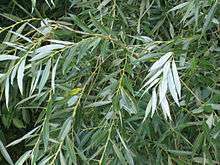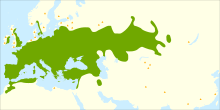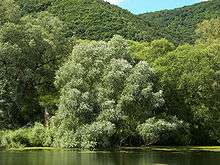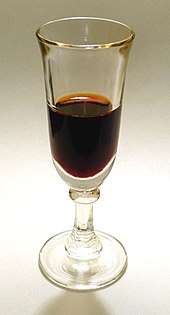Salix alba
Salix alba, the white willow, is a species of willow native to Europe and western and central Asia.[1][2] The name derives from the white tone to the undersides of the leaves.
| Salix alba | |
|---|---|
 | |
| White Willow foliage; note white undersides of leaves | |
| Scientific classification | |
| Kingdom: | Plantae |
| Clade: | Tracheophytes |
| Clade: | Angiosperms |
| Clade: | Eudicots |
| Clade: | Rosids |
| Order: | Malpighiales |
| Family: | Salicaceae |
| Genus: | Salix |
| Species: | S. alba |
| Binomial name | |
| Salix alba | |
 | |
| Distribution map | |
It is a medium-sized to large deciduous tree growing up to 10–30 m tall, with a trunk up to 1 m diameter and an irregular, often-leaning crown. The bark is grey-brown, and deeply fissured in older trees. The shoots in the typical species are grey-brown to green-brown. The leaves are paler than most other willows, due to a covering of very fine, silky white hairs, in particular on the underside; they are 5–10 cm long and 0.5–1.5 cm wide. The flowers are produced in catkins in early spring, and pollinated by insects. It is dioecious, with male and female catkins on separate trees; the male catkins are 4–5 cm long, the female catkins 3–4 cm long at pollination, lengthening as the fruit matures. When mature in midsummer, the female catkins comprise numerous small (4 mm) capsules, each containing numerous minute seeds embedded in white down, which aids wind dispersal.[1][2][3]
Ecology

White willows are fast-growing, but relatively short-lived, being susceptible to several diseases, including watermark disease caused by the bacterium Brenneria salicis (named because of the characteristic 'watermark' staining in the wood; syn. Erwinia salicis) and willow anthracnose, caused by the fungus Marssonina salicicola. These diseases can be a serious problem on trees grown for timber or ornament.
It readily forms natural hybrids with crack willow Salix fragilis, the hybrid being named Salix × rubens Schrank.[1]
Varieties, cultivars and hybrids
A number of cultivars and hybrids have been selected for forestry and horticultural use:[1][2]
- Salix alba 'Caerulea' (cricket-bat willow; syn. Salix alba var. caerulea (Sm.) Sm.; Salix caerulea Sm.) is grown as a specialist timber crop in Britain, mainly for the production of cricket bats, and for other uses where a tough, lightweight wood that does not splinter easily is required. It is distinguished mainly by its growth form, very fast-growing with a single straight stem, and also by its slightly larger leaves (10–11 cm long, 1.5–2 cm wide) with a more blue-green colour. Its origin is unknown; it may be a hybrid between white willow and crack willow, but this is not confirmed.[1]
- Salix alba 'Vitellina' (golden willow; syn. Salix alba var. vitellina (L.) Stokes) is a cultivar grown in gardens for its shoots, which are golden-yellow for one to two years before turning brown. It is particularly decorative in winter; the best effect is achieved by coppicing it every two to three years to stimulate the production of longer young shoots with better colour. Other similar cultivars include 'Britzensis', 'Cardinal', and 'Chermesina', selected for even brighter orange-red shoots.
- Salix alba 'Vitellina-Tristis' (golden weeping willow, synonym 'Tristis') is a weeping cultivar with yellow branches that become reddish-orange in winter. It is now rare in cultivation and has been largely replaced by Salix x sepulcralis 'Chrysocoma'. It is, however, still the best choice in very cold parts of the world, such as Canada, the northern US, and Russia.
- The variety Salix alba var. sericea (silver willow) has gained the Royal Horticultural Society’s Award of Garden Merit.[4][5]
- The golden hybrid weeping willow (Salix × sepulcralis 'Chrysocoma') is a hybrid between white willow and Peking willow Salix babylonica.
Uses
The wood is tough, strong, and light in weight, but has minimal resistance to decay. The stems (withies) from coppiced and pollarded plants are used for basket-making. Charcoal made from the wood was important for gunpowder manufacture. The bark tannin was used in the past for tanning leather.[1][2] The wood is used to make cricket bats. S. alba wood has a low density and a lower transverse compressive strength. This allows the wood to bend, which is why it can be used to make baskets. Willow bark contains indole-3-butyric acid, which is a plant hormone stimulating root growth; willow trimmings are sometimes used to clone rootstock in place of commercially synthesized root stimulator.[6] It is also used for ritual purposes by Jews on the holiday of Sukkot.[7]
Medicinal uses

Hippocrates, Galen, Pliny the Elder and others believed willow bark could ease aches and pains and reduce fevers.[8] It has long been used in Europe and China for the attempted treatment of these conditions.[9] This remedy is also mentioned in texts from ancient Egypt, Sumer, and Assyria.[10] The first "clinical trial" was reported by Reverend Edward Stone, a vicar from Chipping Norton in Oxfordshire, England, in 1763 with a successful treatment of malarial fever with the willow bark.[8][11] The bark is often macerated in ethanol to produce a tincture.
The active extract of the bark, called salicin, after the Latin name Salix, was isolated to its crystalline form in 1828 by Henri Leroux, a French pharmacist, and Raffaele Piria, an Italian chemist, who then succeeded in separating out the acid in its pure state. Salicylic acid, like aspirin, is a chemical derivative of salicin.
References
- Meikle, R. D. (1984). Willows and Poplars of Great Britain and Ireland. BSBI Handbook No. 4. ISBN 0-901158-07-0.
- Rushforth, K. (1999). Trees of Britain and Europe. Collins ISBN 0-00-220013-9.
- Mitchell, A. F. (1974). A Field Guide to the Trees of Britain and Northern Europe. Collins ISBN 0-00-212035-6
- "RHS Plantfinder - Salix alba var. sericea". Retrieved 11 October 2018.
- "AGM Plants - Ornamental" (PDF). Royal Horticultural Society. July 2017. p. 85. Retrieved 11 October 2018.
- "How to Make a Rooting Tonic". Retrieved 23 Aug 2015.
- Shulchan Aruch Harav. Ch. 647: Kehot Publication Society. p. 332.CS1 maint: location (link)
- Norn, S.; Permin, H.; Kruse, P. R.; Kruse, E. (2009). "[From willow bark to acetylsalicylic acid]". Dansk Medicinhistorisk Årbog (in Danish). 37: 79–98. PMID 20509453.
- "Willow bark". University of Maryland Medical Center. University of Maryland. Retrieved 19 December 2011.
- Seaman, David R. (19 July 2011). "White Willow Bark: The Oldest New Natural Anti-Inflammatory/Analgesic Agent". The American Chiropractor. Archived from the original on 21 April 2012. Retrieved 19 December 2011.
- Stone, E. (1763). An Account of the Success of the Bark of the Willow in the Cure of Agues. Philosophical Transactions of the Royal Society of London 53.
Further reading
- Morader, H. L.; Prego, I. A.; Facciuto, G. R.; Maldonado, S. B. (November 2000). "Storage Behavior of Salix alba and Salix matsudana Seeds". Annals of Botany. 86 (5): 1017–1021. doi:10.1006/anbo.2000.1265. JSTOR 42770865.
- van Casteren, A.; Sellers, W. I.; Thorpe, S. K. S. (23 November 2011). "Why don't branches snap? The mechanics of bending failure in three temperate angiosperm trees". Trees. 26 (3): 789–797. doi:10.1007/s00468-011-0650-y.
- Vennetier, Michel (February 2015). "Tree root architecture: new insights from a comprehensive study on dikes" (PDF). Plant and Soil. 387 (1–2): 81–101. doi:10.1007/s11104-014-2272-9.
External links

- Salix alba — information, genetic conservation units and related resources. European Forest Genetic Resources Programme (EUFORGEN)